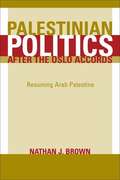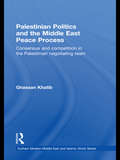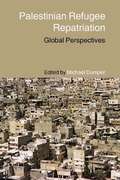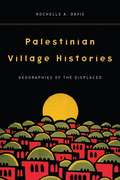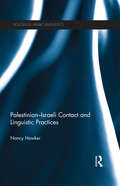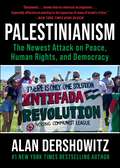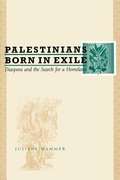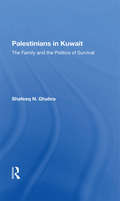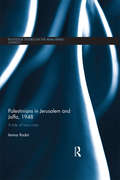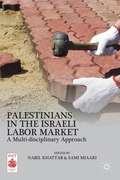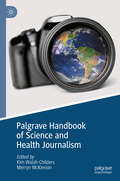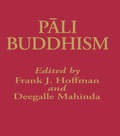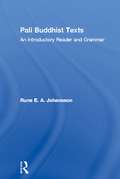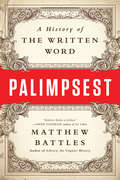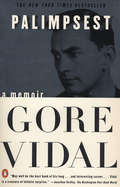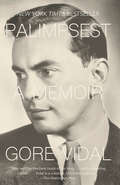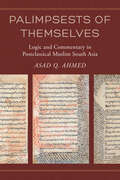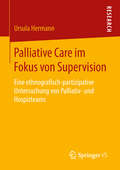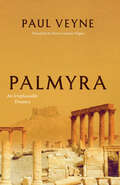- Table View
- List View
Palestinian Politics after the Oslo Accords: Resuming Arab Palestine
by Nathan J. BrownThis timely and critically important work does what hostilities in the Middle East have made nearly impossible: it offers a measured, internal perspective on Palestinian politics, viewing emerging political patterns from the Palestinian point of view rather than through the prism of the Arab-Israeli conflict.
Palestinian Politics and the Middle East Peace Process: Consensus and Competition in the Palestinian Negotiating Team (Durham Modern Middle East and Islamic World Series)
by Ghassan KhatibEight years after the second Palestinian uprising, the Oslo accords signed in 1993 seem to have failed. The reasons for the failure continue to fascinate students, politicians, researchers and policymakers alike. This book explores one of the major aspects of the bilateral peace process – the composition and behaviour of the Palestinian negotiating team, which deeply impacted the outcome of the negotiations between 1991 and 1997. It focuses on the dynamics between the PLO leadership outside the occupied Palestinian territories and the grassroots leadership within the areas under Israeli control that led to conflicts of interest at the time of the final agreement. As the author was a part of the Palestinian leadership in the occupied territories, and was present during the negotiations process in Madrid and Washington DC, the book contains original, unpublished accounts, including those of the Washington bilateral negotiations and crucial internal Palestinian meetings. It is an excellent resource to gain an understanding of Palestinian behavior during peace talks, deterioration in peace-making efforts, the resulting radicalization, and the growing tendency towards violence.
Palestinian Popular Struggle: Unarmed and Participatory (Routledge Studies on the Arab-Israeli Conflict)
by Michael J. CarpenterPalestinian Popular Struggle challenges conventional thinking about political action and organization. It offers an alternative to the seemingly failed tracks of armed struggle and diplomatic negotiations. A discourse of rights and global justice helps bridge national and religious divides, drawing Jewish Israelis and diverse supporters from around the world to participate in direct-action campaigns on the ground in the West Bank. The movement has some important achievements and continues to offer innovative approaches to the Israeli–Palestinian conflict. This book summarizes Palestinian traditions of popular struggle and presents original field research from the West Bank, drawing on several months of participant observation, over twenty-five hours of recorded interviews with Palestinian activists, and more than 200 questionnaires gaging public perceptions about the strategies of the popular committees. One of the book’s major case studies is the village of Nabi Saleh, which recently became well known when one of its activists, a sixteen-year-old girl named Ahed Tamimi, was imprisoned for slapping Israeli soldiers outside her family home. The book offers insight into new waves of Palestinian popular protest, from the 2017 prayer protests in Jerusalem to the 2018 march of return in Gaza. Palestinian Popular Struggle is a valuable resource for researchers and students interested in War and Conflict Studies, Politics and the Middle East.
Palestinian Refugee Repatriation: Global Perspectives (Routledge Studies in Middle Eastern Politics)
by Michael DumperThe repatriation of Palestinians is a highly topical issue, and a critical component of any future peace process for Israel/Palestine. Until now, the mechanics of repatriation have not been dealt with in detail. This book explores the notion that the Palestinian refugee case is exceptional through the comparative study of refugee repatriation, and asks: To what extent can the Palestinian case be said to be unique? Where are the divergences, the overlaps and points of similarity with other refugee situations? What lessons can be drawn from these comparisons? How can these lessons inform refugee organizations, the donor community and policy makers? The expert contributors examine the contextual and methodological field, reviewing the trends in forced migration and refugee studies as well as studying the historical and political background of UNHCR and the negotiations around the Palestinian refugee issue. Taking a comparative approach, the book incorporates case studies of specific refugee situations from around the world, revealing key issues in the formulation of repatriation programmes and highlighting lessons to be learnt.
Palestinian Refugees: Identity, Space and Place in the Levant (Routledge Studies on the Arab-Israeli Conflict)
by Are KnudsenMore than four million Palestinian refugees live in protracted exile across the Middle East. Taking a regional approach to Palestinian refugee exile and alienation across the Levant, this book proposes a new understanding of the spatial and political dimensions of refugee camps across the Middle East. Combining critical scholarship with ethnographic insight, the essays uncover host states’ marginalisation of stateless refugees and shed light on new terminology on refugees, migration and diaspora studies. The impact on the refugee community is detailed in novel studies of refugee identity, memory and practice and new legal approaches to compensation and "right of return". The book opens a critical debate on key concepts and proposes a new understanding of the spatial and political dimensions of refugee camps, better understood as laboratories of Palestinian society and "state-in-making". This strong collection of original essays is an essential resource for scholars and students in refugee studies, forced migration, disaster studies, legal anthropology, urban studies, international law and Middle East history.
Palestinian Village Histories: Geographies of the Displaced
by Rochelle A. DavisThroughout modern-day Israel, over four hundred Palestinian villages were depopulated in the 1947-1949 war. With houses mostly destroyed, mosques and churches put to other uses, and cemeteries plowed under, Palestinian communities were left geographically dispossessed. Palestinians have since carried their village names, memories, and possessions with them into the diaspora, transforming their lost past into local histories in the form of "village memorial books". Numbering more than 100 volumes in print, these books recount family histories, cultural traditions, and the details of village life, revealing Palestinian history through the eyes of Palestinians. Through a close examination of these books and other commemorative activities,Palestinian Village Historiesreveals how history is written, recorded, and contested, as well as the roles that Palestinian conceptions of their past play in contemporary life. Moving beyond the grand narratives of 20th century political struggles, this book analyzes individual and collective historical accounts of everyday life in pre-1948 Palestinian villages as composed today from the perspectives of these long-term refugees.
Palestinian-Israeli Contact and Linguistic Practices (Routledge Arabic Linguistics Series)
by Nancy HawkerOffering insight into linguistic practices resulting from different kinds of Palestinian-Israeli contact, this book examines a specific conceptualisation of the link between the political and economic contexts and human practices, or between structure and agency, termed "articulation". The contexts of the military occupation, a shared consumer market, controlled cheap labour migration, and the provision of social services, supply the setting for power relations between Israelis and Palestinians which give rise to a variety of linguistic practices. Among these practices is the borrowing of Hebrew words and phrases for use in Palestinians’ Arabic speech. Hebrew borrowings can demarcate in-groups, signal aspirations to a modern lifestyle, and give a political edge to humour. Nancy Hawker’s explanation for these practices moves away from the notions of conflict and national identity and gives prominence to Palestinian and Israeli ideologies that inform the conceptual experience of Palestinians. Addressing an understudied linguistic situation, Palestinian-Israeli Contact and Linguistic Practices brings us documentation and analysis of recent casework, firmly anchored in empirical results from fieldwork in three refugee camps in the Occupied Palestinian Territories. Combining sociolinguistics with politics, economics, sociology and philosophy this book will be of great interest to students and scholars of Middle East Studies, Linguistics and Political Theory.
Palestinianism: The Newest Attack on Peace, Human Rights, and Democracy
by Alan DershowitzPalestinianism is not only the newest manifestation of anti-Semitism; it also poses grave threats to peace, human rights, and democratic values. Its dangers must be exposed and challenged in the marketplace of ideas. It is the purpose of this book to pose that challenge and to put Palestinianism on trial for the moral crimes of bigotry, incitement to violence, and destroying any prospects for peace. By &“Palestinianism,&” Alan Dershowitz does not mean merely supporting a Palestinian state or the rights and well-being of the Palestinian people. Those are entirely reasonable positions to take. He means only the obsessive focus on the claims of Palestinians and their supporters—to the exclusion or minimization of the claims of other, more deserving, groups. This singular focus on the &“rights&” of Palestinians is coupled with an equivalent singular focus on the alleged &“wrongs&” of only one country—Israel, the nation-state of the Jewish people. It is the coupling of these biases that constitutes the new &“Palestinianism&” that we are now experiencing on university campuses, in international organizations, among hard-left politicians, and in many media. In Palestinianism, Dershowitz explores the sources of contemporary Jew-hatred, Israel demonization, and other threats to Jewish communities around the world. He demonstrates why he believes things are likely to get worse, as they did in Germany during the late 1930s. He does not believe they will culminate in another genocidal holocaust but that when the young bigots who so fervently rally behind Palestinianism grow into influential adults, they will increase the hatred against Jews and their nation-state. He argues that Jews and their state must become more self-reliant, and less dependent on the approval, support, or selection by others.
Palestinians Born in Exile: Diaspora and the Search for a Homeland
by Juliane HammerIn the decade following the 1993 Oslo Peace Accords, some 100,000 diasporic Palestinians returned to the West Bank and Gaza. <P><P>Among them were children and young adults who were born in exile and whose sense of Palestinian identity was shaped not by lived experience but rather through the transmission and re-creation of memories, images, and history. As a result, "returning" to the homeland that had never actually been their home presented challenges and disappointments for these young Palestinians, who found their lifeways and values sometimes at odds with those of their new neighbors in the West Bank and Gaza.
Palestinians In Kuwait: The Family And The Politics Of Survival
by Shafeeq N GhabraThe research, field work and writing for this study have taken over two years. The book was originally written as a Ph.D. dissertation under the supervision of Professor James Bill of the University of Texas (at Austin). I am grateful to him for his careful and considerate attention to the manuscript at its several stages. I wish to thank Professor Henry Dietz, Robert Femea, Lawrence Graham, and Robert Hardgrave, who provided important suggestions for the writing of this study. Four more individuals deserve particular mention for their contribution to the writing of the book. Dr. Barbara Harlow who took time to read the entire manuscript and Dr. Michael Fischer who read part. I thank both of them for the valuable suggestions provided to me. I wish to express my gratitude to Dr. Ghassan Salame of the American University of Beirut whose support encouraged me to turn my Ph.D. dissertation into a book. Finally, I would like to thank Barbara Ellington, senior acquisition editor of W estview Press, for her support
Palestinians in Jerusalem and Jaffa, 1948: A Tale of Two Cities (Routledge Studies on the Arab-Israeli Conflict)
by Itamar RadaiBetween November 1947 and May 1948 war between the Palestinian Arab community and the Jewish community encompassed Palestine, with Jerusalem and Jaffa becoming focal points in the conflict due to their centrality, size and symbolic importance. Palestinians in Jerusalem and Jaffa, 1948 examines Palestinian Arab society, institutions, and fighters in Jerusalem and Jaffa during the conflict. It is one of the first books in English that deals with the Palestinian Arabs at this crucial and tragic moment in their history, with extensive use of Arabic sources and an inquiry from the Palestinian vantage point. It examines the causes of the social collapse of the Palestinian Arab communities in Jerusalem and Jaffa during the 1948 inter-communal war, and the impact of this collapse on the military defeat. This book reveals that the most important internal factors to the Palestinian defeat were the social changes that took place in Arab society during the British Mandate, namely internal migration from rural areas to the cities, the shift from agriculture to wage labour, and the rise of the urban middle class. By looking beyond the well-established external factors, this study uncovers how modernity led to a breakdown within Palestinian Arab society, widening social fissures without producing effective institutions, and thus alienating social classes both from each other and from the leadership. With careful examination of a range of sources and informed analysis of Palestinian social history, Palestinians in Jerusalem and Jaffa, 1948 is a key resource for students and scholars interested in the modern Middle East, Palestinian Studies, the Arab-Israeli conflict and Israel Studies.
Palestinians in the Israeli Labor Market
by Nabil Khattab Sami MiaariBringing together important contributions from leading Israeli Jewish and Palestinian scholars, this comprehensive and multi-disciplinary volume addresses the most recent developments and outcomes of the labor market integration of the Palestinian minority inside Israel.
Paletó and Me: Memories of My Indigenous Father
by Aparecida VilaçaWinner of the prestigious Casa de las Américas Prize, this work spins a heartfelt story of an improbable relationship between an anthropologist and her charismatic Indigenous father. When Aparecida Vilaça first traveled down the remote Negro River in Amazonia, she expected to come back with notebooks and tapes full of observations about the Indigenous Wari' people—but not with a new father. In Paletó and Me, Vilaça shares her life with her adoptive Wari' family, and the profound personal transformations involved in becoming kin. Paletó—unfailingly charming, always prepared with a joke—shines with life in Vilaça's account of their unusual father-daughter relationship. Paletó was many things: he was a survivor, who lived through the arrival of violent invaders and diseases. He was a leader, who taught through laughter and care, spoke softly, yet was always ready to jump into the unknown. He could shift seamlessly between the roles of the observer and the observed, and in his visits to Rio de Janeiro, deconstructs urban social conventions with ease and wit. Begun the day after Paletó's death at the age of 85, Paletó and Me is a celebration of life, weaving together the author's own memories of learning the lifeways of Indigenous Amazonia with her father's testimony to Wari' persistence in the face of colonization. Speaking from the heart as both anthropologist and daughter, Vilaça offers an intimate look at Indigenous lives in Brazil over nearly a century.
Palgrave Handbook of Critical Posthumanism
by Manuela Rossini Stefan Herbrechter Ivan Callus Marija Grech Megen de Bruin-Molé Christopher John MüllerPalgrave Handbook of Critical Posthumanism is a major reference work on the paradigm emerging from the challenges to humanism, humanity, and the human posed by the erosion of the traditional demarcations between the human and nonhuman. This handbook surveys and speculates on the ways in which the posthumanist paradigm emerged, transformed, and might further develop across the humanities. With its focus on the posthuman as a figure, on posthumanism as a social discourse, and on posthumanisation as an on-going historical and ontological process, the volume highlights the relationship between the humanities and sciences. The essays engage with posthumanism in connection with subfields like the environmental humanities, health humanities, animal studies, and disability studies. The book also traces the historical representations and understanding of posthumanism across time. Additionally, the contributions address genre and forms such as autobiography, games, art, film, museums, and topics such as climate change, speciesism, anthropocentrism, and biopolitics to name a few. This handbook considers posthumanism’s impact across disciplines and areas of study.
Palgrave Handbook of Science and Health Journalism
by Kim Walsh-Childers Merryn McKinnonThis handbook reviews the extant literature on the most important issues in health and science journalism, with a focus on summarizing the relevant research and identifying key questions that are yet to be answered. It explores challenges and best practices in health and science reporting, formats and audiences, key topics such as climate change, pandemics and space science, and the ethics and political impacts of science and health journalist practice. With numerous international contributions, it provides a comprehensive overview of an emerging area of journalism studies and science communication.
Pali Buddhism
by Frank Hoffman Deegalle MahindaThis is an interdisciplinary and holistic survey of Pali Buddhism, covering philological, indigenous and philosophical approaches in a single volume.The work is divided into three main sections: Philological Foundations; Insiders' Understandings; and Philosophical Implications.
Pali Buddhist Texts: An Introductory Reader and Grammar
by Rune E. JohanssonPali is one of the Middle Indian idioms and the classical language of Theravada Buddhism. It is therefore important both to linguists and students of Buddhism. This introductory book centres on a collection of original texts, each selected as an especially important and beautiful formulation of a Buddhist idea. By means of a vocabulary, translation and commentary, each text is explained so concretely that it can be read with little preparation. Detailed explanations are provided for the many technical terms, which have frustrated so many western explorers of Buddhism. For reference, a grammar is provided. Sanskrit parallels to many of the words are given, as well as a special chapter comparing the two languages.
Palimpsest: A History of the Written Word
by Matthew BattlesA profound, eloquent meditation on the history of writing, from Mesopotamia to multimedia. Why does writing exist? What does it mean to those who write? Born from the interplay of natural and cultural history, the seemingly magical act of writing has continually expanded our consciousness. Portrayed in mythology as either a gift from heroes or a curse from the gods, it has been used as both an instrument of power and a channel of the divine; a means of social bonding and of individual self-definition. Now, as the revolution once wrought by the printed word gives way to the digital age, many fear that the art of writing, and the nuanced thinking nurtured by writing, are under threat. But writing itself, despite striving for permanence, is always in the midst of growth and transfiguration. Celebrating the impulse to record, invent, and make one's mark, Matthew Battles reenchants the written word for all those susceptible to the power and beauty of writing in all of its forms.
Palimpsest: A Memoir (Primera Persona Ser.)
by Gore VidalThis explosively entertaining memoir abounds in gossip, satire, historical apercus, and trenchant observations. Vidal's compelling narrative weaves back and forth in time, providing a whole view of the author's celebrated life, from his birth in 1925 to today, and features a cast of memorable characters—including the Kennedy family, Marlon Brando, Anais Nin, and Eleanor Roosevelt.
Palimpsest: A Memoir (Vintage International)
by Gore VidalVidal on Vidal—a great and supremely entertaining writer on a great and endlessly fascinating subject.A New York Times best American memoir&“In the hands of Gore Vidal, a pen is a sword. And he points it at the high and mighty who have crossed his path.&” —Los Angeles Times Palimpsest is Gore Vidal's account of the first thirty-nine years of his life as a novelist, dramatist, critic, political activist and candidate, screenwriter, television commentator, controversialist, and a man who knew pretty much everybody worth knowing (from Amelia Earhart to Eleanor Roosevelt, the Duke and the Duchess of Windsor, Jack Kennedy, Jaqueline Kennedy, Jack Kerouac, Truman Capote, Andre Gide, and Tennessee Williams, and on and on). Here, recalled with the charm and razor wit of one of the great raconteurs of our time, are his birth into a DC political clan; his school days; his service in World War II; his emergence as a literary wunderkind in New York; his time in Hollywood, London, Paris and Rome; his campaign for Congress (outpolling JFK in his district); and his legendary feuds with, among many others, Truman Capote and William F. Buckley. At the emotional heart of this book is his evocation of his first and greatest love, boyhood friend Jimmy Trimble, killed in battle on Iwo Jima.
Palimpsests of Themselves: Logic and Commentary in Postclassical Muslim South Asia (Berkeley Series in Postclassical Islamic Scholarship #5)
by Asad Q. AhmedA free open access ebook is available upon publication. Learn more at www.luminosoa.org.Palimpsests of Themselves is an intervention in current discussions about the fate of philosophy in postclassical Islamic intellectual history. Asad Q. Ahmed uses as a case study the most advanced logic textbook of Muslim South Asia, The Ladder of the Sciences, presenting in English its first full translation and extended commentary. He offers detailed assessments of the technical contributions of the work, explores the social and institutional settings of the vast commentarial response it elicited, and develops a theory of the philosophical commentary that is internal to the tradition. These approaches to the commentarial text complicate presuppositions upon which questions of Islam’s intellectual decline are erected. As such, Ahmed offers a unique and powerful opportunity to understand the transmission of knowledge across the Islamic world.
Palliative Care im Fokus von Supervision: Eine Ethnografisch-partizipative Untersuchung Von Palliativ- Und Hospizteams
by Ursula HermannUrsula Hermann geht den Fragen nach, wie Hospiz- und Palliativteams ihre beruflichen Anforderungen erleben und welche Themen sie in der Supervision zur Sprache bringen. Dafür untersucht sie das Feld der Hospiz- und Palliativversorgung mithilfe des Beratungssettings Supervision. Die ethnografische Methode der teilnehmenden Beobachtung gewährt Einblicke in Beratungsprozesse, die partizipative Forschungsstrategie ermöglicht eine Teilhabe an den Forschungsergebnissen für Supervisandinnen und Supervisanden. Die Erfahrungen und Handlungspraktiken der Berufsgruppen machen deutlich, welche Themenvielfalt sich in der Betreuung und Versorgung von Sterbenden und schwer kranken Menschen zeigt und welche Herausforderungen eine organisationale Einbettung von Palliative Care mit sich bringt.
Palm Beach, Mar-a-Lago, and the Rise of America's Xanadu
by Les StandifordFrom the first Gilded Age to the second, a “charming, zippy history . . . a rollicking, informative lesson in real estate, American history, and current events.” —Town & CountryLooking at the island of Palm Beach today, with its unmatched mansions, tony shops, and pristine beaches, one is hard pressed to visualize the dense tangle of Palmetto brush and mangroves that it was when visionary entrepreneur and railroad tycoon Henry Flagler first arrived there in April 1893. Trusting his remarkable instincts, he built the Royal Poinciana Hotel within a year, and two years later, what was to become the legendary Breakers—instantly establishing the island as the preferred destination for those who could afford it. Over the next 125 years, Palm Beach has become synonymous with exclusivity—especially its most famous residence, Mar-a-Lago. As Les Standiford relates, the high walls of Mar-a-Lago and other manses like it were seemingly designed to contain scandal within as much as keep intruders out.This book tells the history of this fabled landscape intertwined with the colorful lives of its famous and infamous protagonists, from Flagler’s two wives to architect Addison Mizner, who created Palm Beach’s “Mediterranean look” to heiress Marjorie Merriweather Post and her husband E. F. Hutton, the original residents of Mar-a-Lago. With authoritative detail, Standiford recounts how Marjorie ruled Palm Beach society until her death in 1973, and how the fate of her mansion threatened to tear apart the very fabric of the town until Donald Trump acquired it in 1985.“Edifying, energetic, and captivating.” —Florida Weekly
Palma Africana
by Michael Taussig“It is the contemporary elixir from which all manner of being emerges, the metamorphic sublime, an alchemist’s dream.” So begins Palma Africana, the latest attempt by anthropologist Michael Taussig to make sense of the contemporary moment. But to what elixir does he refer? Palm oil. Saturating everything from potato chips to nail polish, palm oil has made its way into half of the packaged goods in our supermarkets. By 2020, world production will be double what it was in 2000. In Colombia, palm oil plantations are covering over one-time cornucopias of animal, bird, and plant life. Over time, they threaten indigenous livelihoods and give rise to abusive labor conditions and major human rights violations. The list of entwined horrors—climatic, biological, social—is long. But Taussig takes no comfort in our usual labels: “habitat loss,” “human rights abuses,” “climate change.” The shock of these words has passed; nowadays it is all a blur. Hence, Taussig’s keen attention to words and writing throughout this work. He takes cues from precursors’ ruminations: Roland Barthes’s suggestion that trees form an alphabet in which the palm tree is the loveliest; William Burroughs’s retort to critics that for him words are alive like animals and don’t like to be kept in pages—cut them and the words are let free. Steeped in a lifetime of philosophical and ethnographic exploration, Palma Africana undercuts the banality of the destruction taking place all around us and offers a penetrating vision of the global condition. Richly illustrated and written with experimental verve, this book is Taussig’s Tristes Tropiques for the twenty-first century.
Palmyra: An Irreplaceable Treasure
by Paul Veyne Teresa Lavender FaganLocated northeast of Damascus, in an oasis surrounded by palms and two mountain ranges, the ancient city of Palmyra has the aura of myth. According to the Bible, the city was built by Solomon. Regardless of its actual origins, it was an influential city, serving for centuries as a caravan stop for those crossing the Syrian Desert. It became a Roman province under Tiberius and served as the most powerful commercial center in the Middle East between the first and the third centuries CE. But when the citizens of Palmyra tried to break away from Rome, they were defeated, marking the end of the city’s prosperity. The magnificent monuments from that earlier era of wealth, a resplendent blend of Greco-Roman architecture and local influences, stretched over miles and were among the most significant buildings of the ancient world—until the arrival of ISIS. In 2015, ISIS fought to gain control of the area because it was home to a prison where many members of the outlawed Muslim Brotherhood had been held, and ISIS went on to systematically destroy the city and murder many of its inhabitants, including the archaeologist Khaled al-Asaad, the antiquities director of Palymra. In this concise and elegiac book, Paul Veyne, one of Palymra’s most important experts, offers a beautiful and moving look at the history of this significant lost city and why it was—and still is—important. Today, we can appreciate the majesty of Palmyra only through its pictures and stories, and this book offers a beautifully illustrated memorial that also serves as a lasting guide to a cultural treasure.
